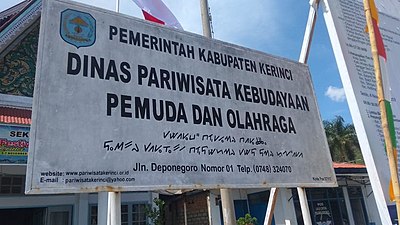Ulu scripts
Writing system family from Sumatra, Indonesia From Wikipedia, the free encyclopedia
The Ulu scripts, locally known as Surat Ulu ('upstream script')[1][a] are a family of writing systems found in central and south Sumatra, in the regions of Kerinci, Bengkulu, Palembang and Lampung, Indonesia. They were used to write manuscripts in Sumatran languages and Malay. The Malay writing was gradually replaced by the Jawi script, a localized version of the Arabic script.[2]
| Ulu scripts | |
|---|---|
 | |
| Script type | |
Time period | c. 13th–present |
| Direction | Left-to-right |
| Region | Sumatra, Indonesia |
| Languages | Malay, Bengkulu, Kerinci, Lampung, Rejang, Serawai, and others |
| Related scripts | |
Parent systems | |
Sister systems | Balinese Batak Baybayin scripts Javanese Lontara Makasar Old Sundanese |
| Unicode | |
| |
| Part of a series on | |
|---|---|
| |
| Writing systems used in Indonesia | |
| Brahmic scripts | |
| Arabic script | |
| Hangul script | |
| Alphabetical script | |
| Related | |
Naming
Summarize
Perspective
The terms "surat" and "ulu" are the origin of the name Surat Ulu. While "ulu" ('upstream') refers to the highland region where the rivers in South Sumatra and Bengkulu originate (the Barisan Mountains), "Surat" refers to the script. The user community first referred to this script family as Surat Ulu.[3][4][5][b][c]
The Rencong script (Dutch: Rèntjong-schrift) is another well-known naming system. "Rencong" is thought to be derived from the Old Malay word mèncong, which means oblique or italics.[8][9] It could also be derived from the word runcing ('sharp'), as this script family was originally written with a sharp knife tip.[10] Regardless of its origin, Western scholars frequently use this term to refer to this family of scripts.[11][d]
The Kaganga script is another name coined by Mervyn A. Jaspan (1926-1975), an anthropologist at the University of Hull. He was probably not aware that most Brahmi script lineages use KA Ga and Nga as the first characters of the alphabetic order.[12] The name "Kaganga" is derived from the first three letters of the Pāṇini sequence, which is used in the Brahmi (Indian) script family.[11][3][e] This is equivalent to the word "alphabet," which is derived from the names of the first two letters of the Greek alphabet (Α-Β, alpha-beta), and the word "abjad," which is derived from the names of the first four letters of the Arabic alphabet (ا-ب-ج-د, alif-ba-jim-dal).
Several tribes have their own names in addition to the three mentioned above. For example, this script family is known as the surat ʁincung among the Pasemah ethnic group.[14]
Materials
Rencong script was often written on tree bark, bamboo, horns and palmyra-palm leaves.[15]
Disambiguation
The term "Rencong" is often confused with "Rejang", which refers to a specific Rencong alphabet that was used to write various dialects of the Rejang language and for writing Malay in the region.
Distribution
This map below shows the distribution of various Rencong alphabets in South Sumatra:

Galleries
- Detail of a Kerinci manuscript (KITLV Or. 239). The text reads (Voorhoeve's spelling): "haku manangis ma / njaru ka'u ka'u di / saru tijada da / tang [hitu hadik sa]", which is translated by Voorhoeve as: "I am weeping, calling you; though called, you do not come" (hitu adik sa- is the rest of 4th line).
- Signboard of government office buildings in Kerinci Regency
- Street sign in Kerinci Regency
- SDN 1 Podomoro signboard, Pringsewu, Lampung
- Gelumpai inscribed with the Rejang script
See also
Wikimedia Commons has media related to Rencong alphabet.
Notes
Summarize
Perspective
- The term Surat Ulu which refers to the Rencong or Ka-Ga-Nga script is found, among others, in the Mal. 6873, Mal 6874, Mal. 6884, Mal. 6877, and L.Or. 12.247 (Leiden University Library) manuscripts.[1]
- "Surat ulu is a local name and a common term for its supporting community to refer to scripts known as rencong or Ka-Ga-Nga by Western scholars. According to Jalil (from the village of Muara Timput) and Meruki (from the village of Ujung Padang), and Pidin (from the village of Napal Jungur), several informants called the Pallava-derived local scripts as Surat Ulu. Westenenk's notes (1922:95), published in TBG edition 61,[6] demonstrate that the Surat Ulu term is a local term used by the community that supports the Ulu writing tradition."[7]
- "Old people in southern Sumatra frequently refer to the Lampung script as the Ulu script..."[5]
- Regarding the naming relationship between the Rencong script and Surat Ulu, L. C. Westenenk writes as follows:
Toen ik dit eerste opstel schreef, wist ik n.l. niet, of de bij Europeanen gebruikelijke term "rèntjong-schrift" inderdaad ergens door Maleisch wordt gebezigd. Het is mij nu gebleken, dat dit in het landschap Rawas (Palembang) het geval is. Elders noemt men het gewonlijk: soerat oeloe = bovenlandsch schrift.[6]
When I wrote the first essay, I had no idea whether the term "rencong script" used by Europeans was also used by Malay. It has now become clear to me that this is the case in the Rawas (Palembang) landscape. Surat Ulu (upriver scripts) is another name for it.
—Westenenk (1919) - According to Mohammad Noeh, these scripts are "referred to as the Ka Ga Nga writing, which is an ancient script system originating from India."[13]
References
Wikiwand - on
Seamless Wikipedia browsing. On steroids.






